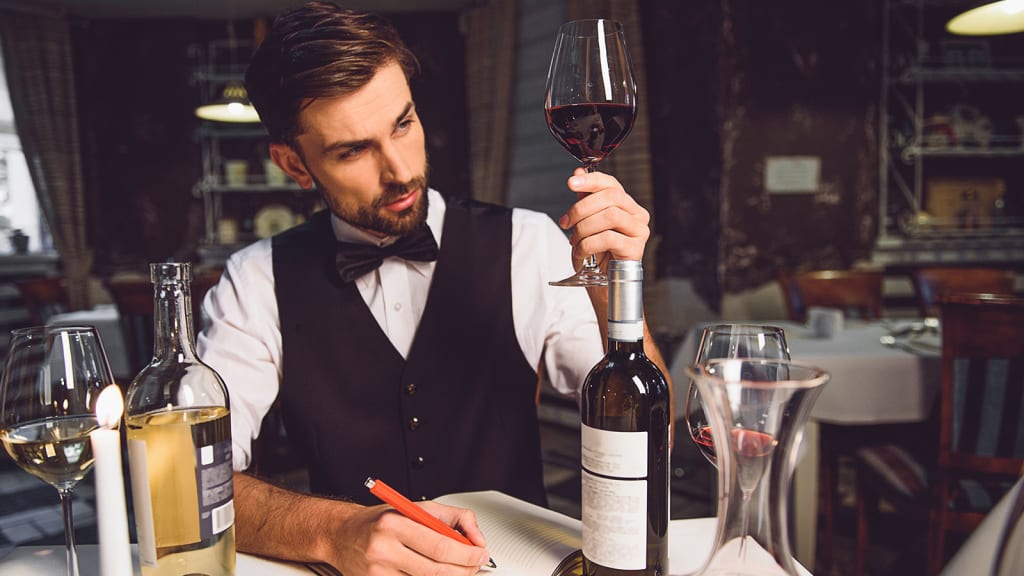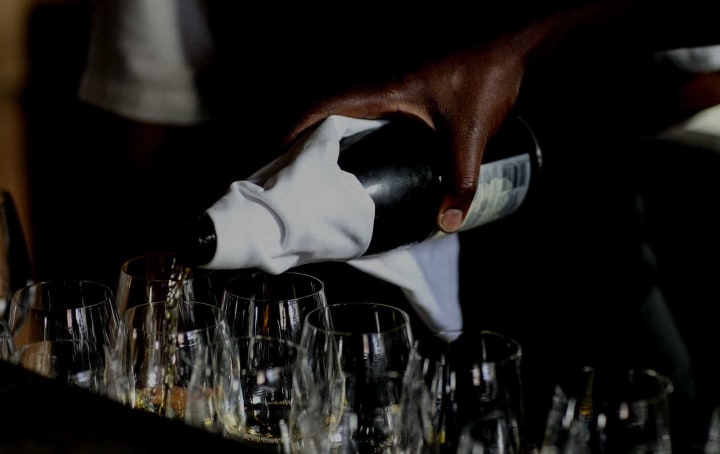Tips for Passing the Sommelier Certification
There's a specific way to set up the glassware as a sommelier. Check out these really helpful tips in getting your sommelier certification.

Whenever I head out for dinner to a really high-end restaurant, I always fancy the sommeliers that would serve me. They're much more experienced and knowledgeable in wine than anyone I've ever come across. Even the way they served caught my attention because it's so distinct and in the most precise manner. I once went to River Palm Terrance in Edgewater, New Jersey, and the steakhouse is pretty high-end. While the sommelier was serving us wine, he looked at my glass, noticed the smallest speck (I didn't even notice it), and said, "I don't like this glass. I'm going to fetch you a much better one." He returned with the cleanest wine glass I've ever seen and served me my wine.
It's aspects like those that fascinate me about sommeliers. I also always wondered, what else does it take to become a sommelier? I wanted to know what sommeliers have to do in order to become one. Since they're well-versed in everything wine-related, I looked up what they need to know and how they get a sommelier certification.
All sommeliers and students should have their own wine guide when before they become the wine guide. This book offers an inside-out perspective on all forms of wine. Sommeliers should know wine like the back of their hands, and the best way to visually understand it all is through this book by Madeline Puckette. Even though drinking wine isn’t tough, distinguishing a great wine requires a much deeper understanding of the fundamentals.
This book, Wine Folly: The Essential Guide to Wine, can lead all aspiring sommeliers right into the world of wine and help them understand all of the differences from red and white, and everything in between. This amazing guide features topics like pairing food and wine, taste profiles on every wine, tips and tricks for serving wine, and more. This is basically the Bible for sommeliers to follow and it’s a great backup resource when you want to look up something.
Theory Examination
All sommeliers should know exactly which vineyard a wine originally came from when wanting to pass the sommelier certification. This is one of the main reasons why geography is crucial to study. When a guest asks where a certain wine bottle imported from, the sommelier should be able to answer their question on the spot.
If a guest is asking about a vintage wine, the sommelier or the student should inform the guest about type of wine, its dryness, what grape it's made from, the location of the vineyard, and any other additional background information. Yes, there’s a lot behind every single bottle and a sommelier should be able to present it all smoothly and clearly for the guest to understand.
The background information on a bottle even gets into depth with the biodynamic symbol on the bottle. Some guests will ask for the meaning behind the symbol and the sommelier should be able to thoroughly explain what the symbol means and information on the philosophy of biodynamics such as how it can affect the wine’s quality, and anything else without overwhelming the guest with a ton of information.
Students should certainly study the country and regional laws, classification, terms of grape growing and winemaking, and major producers for specific wines.
Tasting Examination
If you’re in the process of getting your sommelier certification, you'll definitely be going through a tasting examination. This consists of tasting a white and a red wine and filling out a written grid that’s all based on the Deductive Tasting Method that’s first taught in the Introductory Sommelier Class. This grid requires all students to put information on the wine’s aromas and flavors, the presence of minerality and/or earthiness, and if oak is used.
This grid also asks students to assess the structural components of the wines like the levels of residual sugar, acidity, alcohol, the finish, and tannin in red wine. At the end, students are asked to deduce their best conclusion on the wine including the climate in which the grapes were grown, whether it was Old World or New World style, the grape variety or blend of grapes, the country of origin, and the vintage of production. It takes a lot of practice to perfect the grid and tasting in general.
When it comes to tasting, focus on working in a tasting group because the dynamics of a study group are important in learning the differences as well as improving. Many people find that smelling and tasting is all based on memory. Using your memory can distinguish the aromatics and flavors in wine and the combinations that make up the wine’s profile. Practicing to use your memory can be pretty helpful in finding the components and profiles of grapes in wine and it’s just as important and beneficial as tasting them.
Setting Up

Setting everything up is very very important to know when passing the sommelier certification. You want to fold just two serviettes when serving. One of them will be used to open the bottle and the other will be left laying on the bucket tableside if the bucket will be used for service. Do not fold all of the napkins on the service station; they should be left alone.
Making sure that all of the glassware is spotless and polished is very important when you’re serving wine in these glasses. You definitely wouldn’t want to serve fine wine in a glass that has a spot. You definitely wouldn’t want the guest to notice a spot, either.
Line the tray with an unfolded cloth napkin. Don’t pull off any fancy origami folds because this will lead to an uneven surface that ruins the glassware’s perfect balance. When you begin placing the glassware, place them consistently at every cover. Most sommeliers prefer placing the glass at the point of the knife for the most straightforward tactic. Always start with the host when placing the glasses, then the person to the host’s left. When you’re setting up the glasses, it’s not gender specific, which means you don’t have to bounce around to set the women’s glasses first before the men.
Place two under-liners or coasters to the right of the host. One coaster will be for the cork and the other for the bottle. All of this varies if the host wants to keep the bottle and the cork on the table.
Opening the Bottle
First thing’s first, never ever take the top of your hand off the bottle when you’re opening it. This is very important when you’re opening the bottle in the safest manner and properly. When you’re about to loosen the cage, make sure a folded serviette is placed on top of the bottle. The serviette is there to stop any spillage if the cork suddenly pops open. Have a firm grip over the serviette and loosen the wire cage slowly and carefully. When removing the cage, remove the cork by twisting the bottom of the bottle back and forth. You want to do all of this slowly to prevent a mess and the cork flying out of your hand.
Always keep in mind that the cage is never removed before the cork if you want to successfully pass the sommelier certification.
Being aware of where the bottle is pointing is crucial because you don’t want to point the bottle at the table or anyone else. It should always be away from anyone in your surroundings so no one gets hurt if a mistake occurs.
All sommeliers should open any wine bottle without making any noise. This is the most proper way without seeming like you just finished a mile run. In fact, opening a bottle of sparkling wine quietly takes practice, so start practicing!
After you’ve opened the bottle of wine, wipe the bottle with your serviette because the ice water from the wine bucket will wet the bottle, and you don’t want to serve wine when the bottle is dripping wet. Remember to always present the cork to the host on an underliner or coaster that’s placed to the host’s right.
Serving the Bottle
Now it's time to actually start serving the wine! Make sure you hold the bottle with a still wine grip. Don’t hold the bottle with your thumb in the punt of the bottle when you’re pouring because this doesn’t offer much control and stability. It’s possible to lose your grip and drop the bottle and no one wants to see that happen.
After showing the cork to the host, pour the person about 1 to 1.5 ounces of the wine to taste. Wait patiently until the host approves the wine or gives their concerns. When they approve, serve the table in this specific order: serve the lady guests first then the men. The host is always last regardless of their gender. Fill every glass about 1/2 to 3/4 glass full with a maximum pour of an inch below the top of the glass. When you’re filling the glasses, fill each one at a time with a maximum of two pours each glass. You don’t want to partially pour or go around the table multiple times; make sure all pours are even.
Measure the amount you're pouring based on the size of the glasses and even the number of glasses you’ll be pouring in order to prevent running out of wine. It’s not required to empty the entire bottle, but having a little wine left in the bottle after serving everyone on the table is preferred.
General Service Points

When you want to pass the sommelier certification, there are a couple of general service points you want to know. You should always serve from the right and move around the table clockwise. Even if you’re just returning to the service station, moving clockwise is crucial.
Never, ever reach across a guest’s space in order to place or clear away any glassware or even serve wine. Despite the fact that this is a rude gesture, you can easily knock someone else’s glass. Even if the chair is empty, don’t get into anyone’s space.
Who knew carrying a tray would take a lot of practice? This is certainly a part of service that can’t be handled easily. If you don’t regularly practice working with a tray, you won’t be perfect at it. You should be able to carry a tray comfortably with either hand, but the most proper way to carry a tray is with your left hand and glassware placed with the right hand.
Service Exam Theory
Even sommeliers should know how to whip up major cocktails, aperitifs (drinks before a meal), and after dinner spirits. They’re not just experienced in the wine field! As a practicing sommelier, study cocktails and aperitifs category by category such as martini variations and rum cocktails.
In order to properly pass the sommelier certification, all students should know pairings, such as Italian food and wine pairings, like the back of their hand. They should know specific wine recommendations with the producer and vintage in mind. When you’re coming up with pairs, think about the specific styles like high acid red or white with residual sugar. You should be able to explain why a certain wine works well with a certain dish through the structural components of the wine.
General Service Advice
Lastly, when you’re taking the sommelier certification exam, you should be caring for the table no matter what. Despite the fact that you’re in an exam setting, you are the sommelier and it’s your duty to take care of the table and the guests. When you’re actually presented in a real life situation, you don’t have the option to give up on a table or completely fail at it.
You should care for the guests and offer them the best service you can grant them. Treat the examiner as you would for a guest in the restaurant.
About the Creator
Jacqueline Hanikeh
Reading good literature plays a huge role in my life — and so does online shopping and wine.






Comments
There are no comments for this story
Be the first to respond and start the conversation.